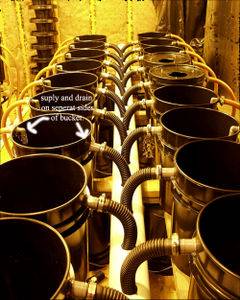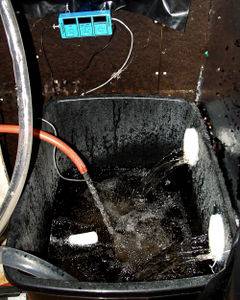Well everyone it’s getting a little difficult going to OG to update my grow/thread documentation when I spend all of my time here at IC, so in order to keep up with every thing I’m going to go head and move it so as to better document as I go.
Introduction:
In conclusion: This system is NOT A TOY SYSTEM, but well rapidly produces fast growing plants with the most ease of maintenance. I well provide some links to the various different types of bio-bucket system styles, enjoy!!!
HurtBack as far as I know he is the one how came up with the principles and design of the Bio-Buckets, although I love the principles behind the bio-bucket system I did not like the design of the system. So I set out on a journey which took me several mounts to complete.
So here's what I did, and some of the things I kept.
And here's some of the things that I changed.
That's just a few things that I did....To bring new ideas to the system, you know what they all ways say, a picture is worth a thousand words, so here you go.
The Bio-Bucket Concepts:
I well try to explain some of the concepts of growing in a bio-bucket system, and sense a lot of people have never heard of "bio-buckets" I'll start with what makes it "bio," I am not referring to the nutrients! I am referring to the beneficial bacterium, there is good and bad bacterium, the good bacterium if put under a microscope is a "short chained bacteria" which are the good one's and feeds off of the bad bacteria which is a "long chained bacteria" which grows when something is non moving and steal and stagnate, that’s way they say to only drink out of fast moving streams because long-chained bad bacteria well build up in a non moving system, so the idea here is to have a recirculating system.
The use of beneficial bacteria populations that can decompose organic sludge as well as bacteria that can convert ammonia and nitrites into nitrates, reduce BOD (biochemical oxygen demand), bind excess phosphates, prevents algal blooms and maintains a microbiological equilibrium in the system. This process has been studied for many years in the water treatment industry and recently has been introduced in aquaculture with very encouraging results. (I well discuss this in more detail later on) so that there is NO DEAD SPOTS in the design of your system.
Now how do you get the beneficial bacterium started in your system, well that's the essayist part of all, you need to give them a home to live in, sense this is a DWC type of system in the bottom of my lid I use an 8" net-pots, DO NOT USE CLAY BALLS, the beneficial bacterium cannot penetrate the heard clay balls, so you won't to use something like "lava rock" or some kind of pumice rock that has tiny little holes in it were the good bacterium can live, Now that you have that just fill up your system with tap water or RO water and live your pump running 24/7 for one week, NOTE: (any thing over 100 gallons, live for two weeks) mine is a 205 gallon system so I fill the system and let it run and in the min time I take my cutting's and by the time thy are rooted the system is ready!
Recap:
Click for Larger Image

Click for Larger Image

Click for Larger Image

Click for Larger Image

Click for Larger Image

Click for Larger Image

Click for Larger Image

Click for Larger Image

Click for Larger Image

Click for Larger Image
Introduction:
- Well I, like most other people probable started growing outside? After a few years of growing outside I decided I would take the skills indoors.
- And for several years I did great!! But I could not get over those hydroponic pictures, then I started looking into going hydro, but after reading lot of different styles of growing hydro I thought it was out of my league. And then I came across the Bio-Bucket section over at OG a few years ago, I thought that was the most fascinating thing I have ever saw, and I new this was duable for a newbie, so with no hydroponic knowledge experience ahead of me it was back to the drawing board.
- Searching researching, searching researching, and allot of reading & more reading & more reading!!!! Several mounts latter I had finely understood the Recirculating DWC Bio-Bucket system, that I thought suited me to the T, and with no Perrier experience in building an home made hydro system I took my time and allot of thought which took several mounts to get all the parts I needed (I HAD TO HAVE THE BEAST) win it came to the parts of building this system.
In conclusion: This system is NOT A TOY SYSTEM, but well rapidly produces fast growing plants with the most ease of maintenance. I well provide some links to the various different types of bio-bucket system styles, enjoy!!!
HurtBack as far as I know he is the one how came up with the principles and design of the Bio-Buckets, although I love the principles behind the bio-bucket system I did not like the design of the system. So I set out on a journey which took me several mounts to complete.
So here's what I did, and some of the things I kept.
- I am a farm believer in the bio-filled of the system, the beneficial bacterium or "bio-filled" is supported in my system by 8" Net-Pots, I have mounted these net-pots underneath the lids, that way they would be submerged in water as far as possible, which is about an inch from the top, and they are full of Lava Rook, this gives the beneficial bacterium and place to live, this good bacterium well keep your systems water clean and healthy, and there is no need to do a change-out of the systems res.....So I kept the bio-principles and they have preformed great for me!!
- The principles of having total circulation, that mines no dead spots at all in the system, if there were dead spots it would germinate bad bacterium or algae in the system and would cause root rot ect.....So I kept the total circulation principles of the bio-system.
And here's some of the things that I changed.
- As far as I know I am the only one to use a 8" Net-Pot in the Bio-Buckets, this was done to harbor more good bacterium in the system,......since I am recirculating 36 bio-buckets and a 25gal res, that makes it a total of 205gal system, that's allot of water so I thought I needed to harbor as much of good bacterium as possible......So I went with a bigger net pots.
- In HurtBacks design, there was no way to empty the buckets or res, except by head......And each bucket had the supply line running up through the drain hose, which reduce in the amount of water derange you could do....and caused some clogging.....In my design each bucket is independently supplied and drained, I also modified the supply it was a ½”, mine is ¾”, to offer a more better supply of Nutrients and a faster supply dissolved oxygen in the system, the drain is now 1"1/4, and I have never had one clog, (at the time when this was written) my plants were in there second week of flowering and there are 4'1/2 to 6' foot tall I even have a couple that is 8' foot tall, and they look great and I have never did a change-out. Also I added a Chiller.
That's just a few things that I did....To bring new ideas to the system, you know what they all ways say, a picture is worth a thousand words, so here you go.
The Bio-Bucket Concepts:
- beneficial bacterium
I well try to explain some of the concepts of growing in a bio-bucket system, and sense a lot of people have never heard of "bio-buckets" I'll start with what makes it "bio," I am not referring to the nutrients! I am referring to the beneficial bacterium, there is good and bad bacterium, the good bacterium if put under a microscope is a "short chained bacteria" which are the good one's and feeds off of the bad bacteria which is a "long chained bacteria" which grows when something is non moving and steal and stagnate, that’s way they say to only drink out of fast moving streams because long-chained bad bacteria well build up in a non moving system, so the idea here is to have a recirculating system.
The use of beneficial bacteria populations that can decompose organic sludge as well as bacteria that can convert ammonia and nitrites into nitrates, reduce BOD (biochemical oxygen demand), bind excess phosphates, prevents algal blooms and maintains a microbiological equilibrium in the system. This process has been studied for many years in the water treatment industry and recently has been introduced in aquaculture with very encouraging results. (I well discuss this in more detail later on) so that there is NO DEAD SPOTS in the design of your system.
Now how do you get the beneficial bacterium started in your system, well that's the essayist part of all, you need to give them a home to live in, sense this is a DWC type of system in the bottom of my lid I use an 8" net-pots, DO NOT USE CLAY BALLS, the beneficial bacterium cannot penetrate the heard clay balls, so you won't to use something like "lava rock" or some kind of pumice rock that has tiny little holes in it were the good bacterium can live, Now that you have that just fill up your system with tap water or RO water and live your pump running 24/7 for one week, NOTE: (any thing over 100 gallons, live for two weeks) mine is a 205 gallon system so I fill the system and let it run and in the min time I take my cutting's and by the time thy are rooted the system is ready!
Recap:
- Recirculating System!
- Beneficial Bacterium!

Click for Larger Image

Click for Larger Image

Click for Larger Image

Click for Larger Image

Click for Larger Image

Click for Larger Image

Click for Larger Image

Click for Larger Image

Click for Larger Image

Click for Larger Image
Last edited:

























































